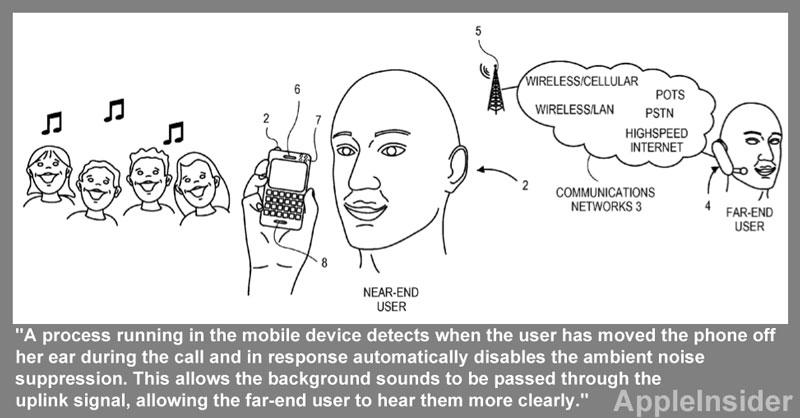Apple's next iPhone could determine wanted vs. unwanted background noise
The idea for a system that could distinguish between wanted and unwanted background noise was revealed in a new patent application discovered this week by AppleInsider. Entitled "Decisions on Ambient Noise Suppression in a Mobile Communications Handset," it describes using noise canceling microphones, proximity sensors and gyroscopes to determine a user's intent.
While background noise is often a nuisance and can degrade call quality, there are occasions where that ambient noise is actually desired. For example, a user may be at a concert and want the person on the other end to hear the music playing in the background, but a smartphone's ambient noise sensor could instead attempt to reduce the noise.
Apple's proposed solution would offer the best of both worlds, allowing a user's voice to be properly heard by reducing unwanted ambient noise, but also intelligently detecting when the user wants the background noise to be heard more clearly.
Take, for example, an iPhone user at the beach. The sounds of the waves would be reduced by an ambient noise suppressing microphone until the user pulled the iPhone away from their ear and pointed it at the water. At that point, the iPhone would disable its ambient noise suppression and allow the caller on the other end to hear the sounds as intended.
"A process running in the mobile device detects when the user has moved the phone off her ear during the call and in response automatically disables the ambient noise suppression," the filing explains. "This allows the background sounds to be passed through the uplink signal, allowing the far-end user to hear them more clearly."
Then, when the iPhone user places the handset back against their ear, the ambient noise suppression on the device will once again kick in, ensuring the best possible call quality.
Both the iPhone 4S and iPhone 4 feature two microphones to reduce ambient noise and improve call quality. In addition to a microphone at the bottom of the device to pick up a user's voice, the handsets also feature a second microphone on top that detects ambient noise and helps to cancel it out.
All iPhone models also include gyroscopes to detect the orientation of the device, and a proximity sensor that disables the touchscreen when it is placed against a user's ear. By using these sensors, the iPhone would intelligently turn off the noise cancelation feature when a user pulls their smartphone away from their ear and holds it up to capture nearby sounds.
The proposed invention made public by the U.S. Patent and Trademark Office this week was first filed by Apple in August of 2010. It is credited to Koji Gardiner, E-cheng Chang, and Jason Rukes.
 Neil Hughes
Neil Hughes











 Malcolm Owen
Malcolm Owen

 William Gallagher
William Gallagher
 Mike Wuerthele
Mike Wuerthele
 Christine McKee
Christine McKee

 Andrew Orr
Andrew Orr
 Sponsored Content
Sponsored Content






